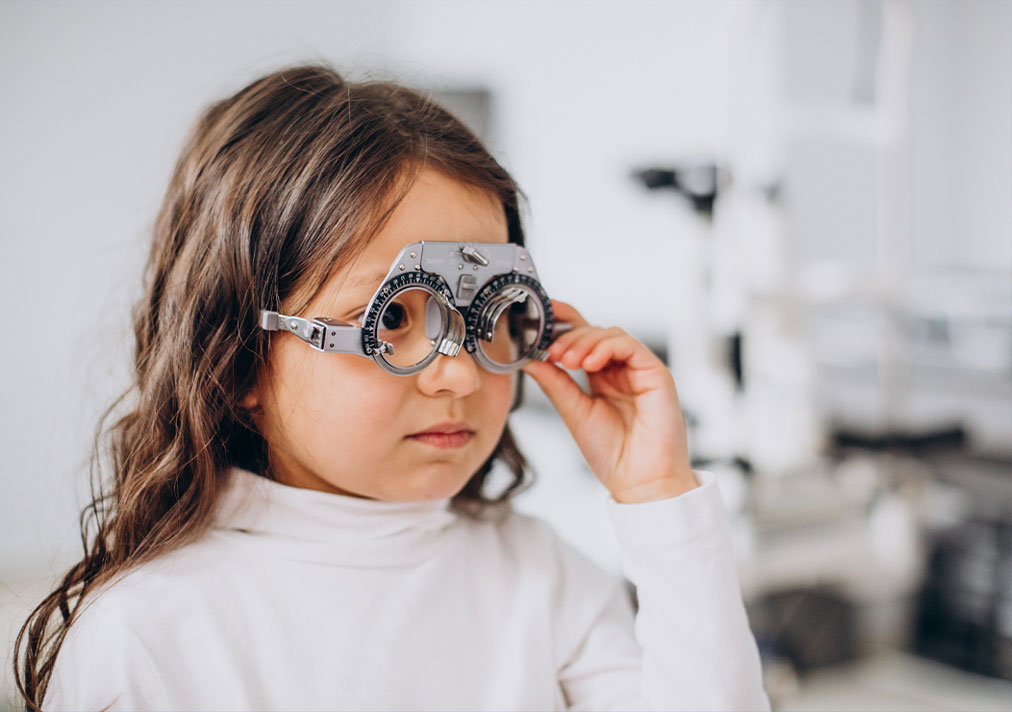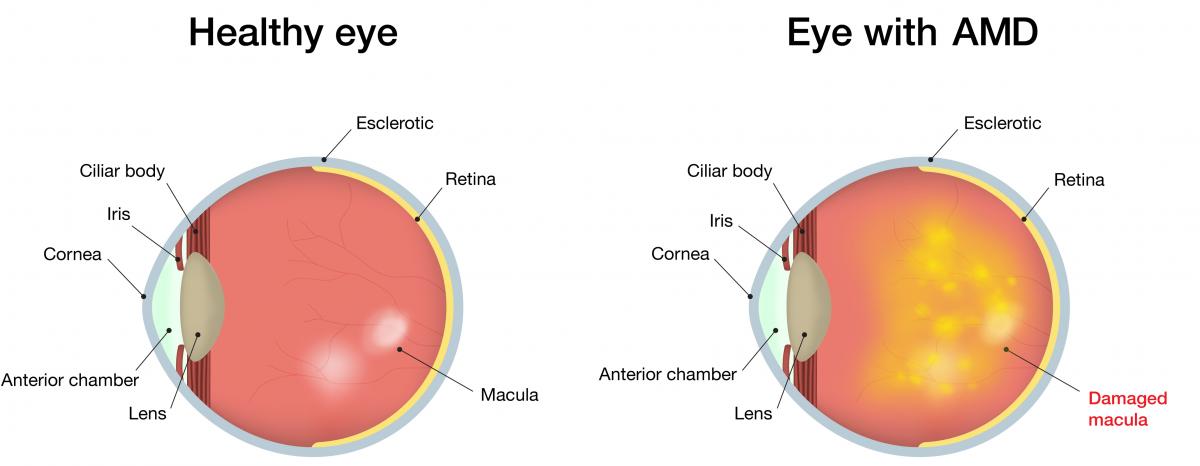Have you ever noticed someone struggling to see even with glasses? Or perhaps you’ve found it harder to read or recognize faces as you age? Age-Related Macular Degeneration (AMD) might be the reason. Imagine trying to read the morning newspaper and finding the center of the page blurry, or looking at a loved one and seeing a dark spot in the middle of their face. AMD, a leading cause of vision loss among older adults, can make these situations all too familiar.
The macula, a small part of the retina, is crucial for clear central vision, enabling us to read, drive, and recognize faces. AMD affects this part of the eye, leading to vision problems that can significantly impact daily life. This blog aims to provide an overview of AMD, including its symptoms, diagnosis, and treatment options, to help you understand this common eye condition better.
What is Age-Related Macular Degeneration (AMD)?
AMD is a degenerative eye disease that affects the macula, the central part of the retina responsible for sharp, detailed vision. When the macula deteriorates, central vision becomes blurred or lost, making tasks like reading or recognizing faces challenging. AMD is one of the leading causes of vision loss in people over 50. There are two main types of AMD:
- Dry AMD (Non-neovascular AMD): This is the more common form, characterized by the presence of drusen, yellow deposits that form beneath the retina.
- Wet AMD (Neovascular AMD): Less common but more severe, wet AMD involves abnormal blood vessel growth beneath the retina. These vessels can leak blood and fluid, leading to rapid and severe vision loss.
Causes and Risk Factors
Several factors contribute to the development of AMD:
- Age: AMD risk increases with age due to cumulative cellular changes in the macula.
- Genetics: Family history indicates genetic predisposition, with certain genes influencing AMD development.
- Smoking: Damages retinal blood vessels and reduces antioxidants, accelerating AMD.
- Race/Ethnicity: Caucasians have higher AMD rates, possibly due to genetic and environmental factors.
- Gender: Women are slightly more prone to AMD, potentially due to hormonal differences.
- Diet: Antioxidants, vitamins, and minerals in fruits, vegetables, and fish may protect against AMD.
- Obesity: Increases systemic inflammation, contributing to AMD development.
- Cardiovascular Health: Hypertension and high cholesterol impair retinal blood flow, increasing AMD risk.
- Sunlight: UV and blue light exposure may accelerate AMD onset.
- Inflammation: Chronic inflammation promotes AMD progression by damaging retinal tissues.
Understanding these causes and risk factors can help individuals take proactive steps to reduce their risk of developing AMD.
Symptoms of AMD
Age-related macular degeneration (AMD) can manifest in various ways, often affecting central vision. Common symptoms include:
- Blurred Vision: A gradual or sudden loss of clarity in the central vision.
- Distorted Vision: Straight lines may appear wavy or bent.
- Dark or Empty Areas: Parts of the central vision may seem dark or empty, making it difficult to see details.
- Difficulty Recognizing Faces: Faces may become harder to recognize, especially when looking directly at them.
- Decreased Contrast Sensitivity: Colors may appear less vibrant, and it may be harder to distinguish between shades.
- Visual Hallucinations: In some cases, people with AMD may experience visual hallucinations, known as Charles Bonnet syndrome, where they see things that aren’t there.
These symptoms can vary in severity and may affect one or both eyes. It’s essential to consult an eye care professional if you experience any changes in your vision, as early detection and treatment can help manage AMD effectively.
Diagnosis of AMD
Age-related macular degeneration (AMD) is typically diagnosed through a combination of a comprehensive eye exam and specialized tests. Here’s a breakdown of the diagnostic process:
- Visual Acuity Test: This standard eye chart test measures how well you see at various distances. It helps identify any central vision abnormalities.
- Dilated Eye Exam: Your eye doctor will use eye drops to dilate your pupils, allowing them to examine the back of your eye, including the macula, optic nerve, and retina, for signs of AMD.
- Fundus Photography: This involves taking detailed photographs of the back of your eye, including the macula. These images help monitor any changes over time and can aid in diagnosing AMD.
- Fluorescein Angiography: In this test, a special dye is injected into your arm, and images are taken as the dye travels through the blood vessels in your retina. It helps identify leaking blood vessels, which are characteristic of wet AMD.
- Optical Coherence Tomography (OCT): This non-invasive imaging test provides cross-sectional images of the retina, allowing your doctor to assess its thickness and detect any abnormalities, such as drusen (small deposits under the retina) or fluid accumulation.
- Amsler Grid Test: This is a simple test where you look at a grid pattern to check for any distortion or missing areas, which may indicate AMD affecting your central vision.
- Genetic Testing: In some cases, genetic testing may be recommended, especially if there is a family history of AMD. Certain genetic factors can increase the risk of developing the condition.
Once diagnosed, the stage and type of AMD (dry or wet) will be determined. This information helps guide treatment and management strategies to preserve vision and slow down disease progression. It is recommended that adults over 50 have a comprehensive eye exam every one to two years.
Treatment Options for AMD
Treatment options for AMD can vary depending on the type and severity of the condition. Here are some common treatment options:
- Anti-VEGF Therapy: This is the most common treatment for wet AMD, which involves abnormal blood vessel growth. Anti-VEGF medications are injected into the eye to inhibit the growth of these blood vessels, reducing leakage and preserving vision.
- Photodynamic Therapy (PDT): PDT involves injecting a light-sensitive drug into the bloodstream, which is then activated by a laser to destroy abnormal blood vessels in the eye.
- Laser Therapy: Laser therapy can be used to seal leaking blood vessels in the eye, particularly in cases of wet AMD. However, this treatment is less commonly used now compared to anti-VEGF therapy.
- Combination Therapy: In some cases, a combination of treatments, such as anti-VEGF therapy with PDT or anti-VEGF therapy with laser therapy, may be used to achieve better outcomes.
- Nutritional Supplements: Some studies suggest that certain vitamins and minerals, such as vitamins C and E, zinc, copper, lutein, and zeaxanthin, may help slow the progression of AMD, especially in its early stages. These are often available in specific formulations known as AREDS (Age-Related Eye Disease Study) supplements.
- Low Vision Aids: For individuals with advanced AMD who experience significant vision loss, low vision aids such as magnifiers, telescopes, and other visual aids can help maximize remaining vision and improve quality of life.
It’s important for individuals with AMD to regularly visit their eye care professional for monitoring and appropriate management of their condition, as early detection and treatment can help preserve vision and prevent further vision loss.
Managing Life with AMD
Age-related macular degeneration (AMD) can indeed present significant challenges, but there are strategies to manage it effectively. Here are some practical tips for coping with AMD:
- Monitor Symptoms: Pay attention to changes in your vision, such as blurriness, distortion, or blind spots. Promptly report any new symptoms to your eye care provider.
- Protect Your Eyes: Shield your eyes from harmful ultraviolet (UV) rays by wearing sunglasses that block both UVA and UVB rays when outdoors. Additionally, use protective eyewear when engaging in activities that could potentially cause eye injury.
- Optimize Lighting: Ensure proper lighting in your home and work environment. Use bright, adjustable lighting and minimize glare by using matte finishes on surfaces and installing blinds or shades to control sunlight.
- Assistive Devices: Explore assistive devices that can help you perform daily tasks more easily. This may include magnifiers, large-print books, electronic reading devices with adjustable font sizes, and smartphone apps designed for individuals with low vision.
- Adapt Your Environment: Make modifications to your living space to enhance safety and accessibility. Use contrasting colors to improve visibility, remove tripping hazards, and install handrails or grab bars where needed.
- Emotional Support: Coping with vision loss can be emotionally challenging. Seek support from family, friends, or a mental health professional if you’re feeling overwhelmed or experiencing symptoms of depression or anxiety.
By incorporating these strategies into your daily routine, you can maintain your independence and quality of life despite having AMD.
Preventing AMD
While some risk factors like age and genetics can’t be changed, there are steps individuals can take to potentially reduce their risk or slow the progression of AMD:
- Healthy Diet: Fruits, veggies, and omega-3s provide antioxidants and nutrients that protect the eyes from damage.
- Weight Management and Exercise: Maintaining a healthy weight and being physically active improve blood flow to the eyes, keeping them healthy.
- Smoking Cessation and UV Protection: Quitting smoking and wearing sunglasses protect against harmful effects on the eyes caused by smoking and UV light exposure.
- Blood Pressure and Cholesterol Control: Managing blood pressure and cholesterol levels supports healthy blood vessels in the eyes, reducing the risk of AMD.
- Regular Eye Exams and Supplements: Routine eye check-ups catch AMD early, and supplements containing specific nutrients can slow its progression.
By incorporating these preventive measures into your lifestyle, you can help reduce your risk of developing AMD or slow its progression if you already have the condition.
Conclusion
Proactive eye health is crucial in preventing and managing AMD. Early detection and treatment can significantly slow the progression of the disease, preserving vision for as long as possible. Regular eye exams and a healthy lifestyle are essential in maintaining good eye health and catching any issues early. Advances in treatment continue to provide hope, and it’s important to consult healthcare professionals for personalized advice and management strategies.




